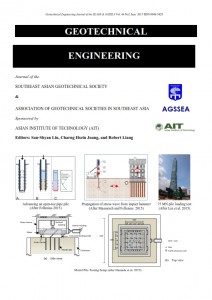Elastic Continuum Solution of Stacked Pile Model for Axial Load-Displacement Analysis
Main Article Content
Abstract
In a companion paper, new sets of shear stiffness reduction curves developed from the back-analyses of 299 static axial pile load tests were presented towards the implementation of a non-linear load-displacement (Q-w) response analysis within the framework of Randolph-type closed-form elastic continuum solution. These curves were developed with the following underlying assumptions: (1) soil stiffness is linear with depth (although certain situations may portray a different trend), and (2) the back-analyzed field stiffnesses can be obtained keeping the operative modulus profile constant throughout the loading (even though shaft resistance is expected to be mobilized prior to the end bearing). In an effort to make some improvements with respect to these conditions, certain provisions of the elastic continuum solution are exploited to present a methodology for drawing the stiffness reduction curves as functions of depth. These curves are further utilized in modeling the pile as a stack of smaller shaft segments embedded in multi-layered soils, where each layer is assigned its own distinctive averaged stiffness. The load-displacement analysis of all pile segments, associated with their adjacent soil layers, can thus be performed using the stiffness reduction curves applicable to their respective depths. The overall load-displacement response is obtained through integration of the analysis result of all layers. Flow charts are presented detailing steps for plotting the depth-dependent stiffness reduction curves. Similarly illustrative figures are included showing the procedures for implementing the stacked pile model for compressible as well as rigid piles.
Article Details

This work is licensed under a Creative Commons Attribution-NonCommercial-NoDerivatives 4.0 International License.
Copyright © 2019 Association of Geotechnical Societies in Southeast Asia (AGSSEA) - Southeast Asian Geotechnical Society (SEAGS).


